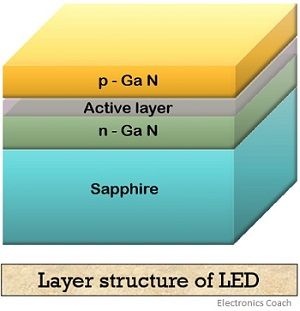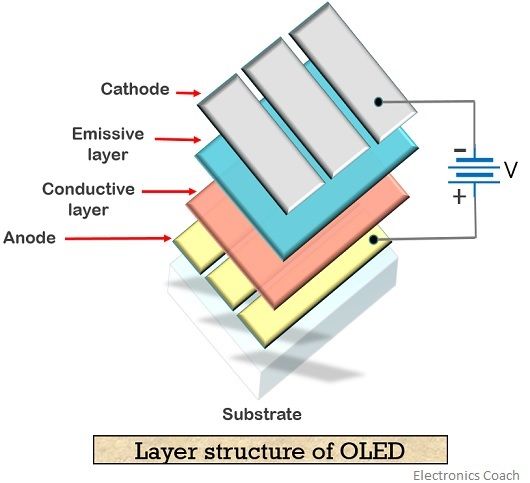The crucial difference between LED and OLED is that LED does not work on the principle of self-illumination as it needs a backlight for its operation. As against OLED is a self-illuminating type device as it does not require a backlight in order to initiate its operation.
Another major difference between LED and OLED is that a wider viewing angle is noticed in the case of OLED. At the same time, black level is more dominant in OLED as compared to LED.
We will discuss some more important differences between LED and OLED by making use of a comparison chart but before proceeding towards that have a look at the contents to be discussed under this article.
Content: LED Vs OLED
Comparison Chart
| Parameter | LED | OLED |
|---|---|---|
| Expands to | Light emitting diode | Organic light emitting diode |
| Power consumption | More | Less |
| Viewing angle | 54° | 84° |
| Cost | Less | More |
| Picture quality | Good | Comparatively better |
| Brightness | More | Less |
| Flexibility | More flexible | Less flexible |
| Size | Large | Comparatively small |
| Lifespan | More | Less |
| Screen Thickness | Thin | Comparatively thinner |
| Weight | Heavy | Lighter in comparison to LED |
| Response time | Slow | Fast |
Definition of LED
LED stands for Light Emitting Diode, in which recombination of electron-hole pair generates heat in the form of light energy. It works on the principle of electroluminescence.
This emitted light is responsible for the production of an image on the screen of the LED display.
The figure below shows you the layered structure of LED:

We are aware of the fact that LED is composed of inorganic semiconductor materials, thus recombination of electron and hole emits energy, this heat energy in LED is made to be released in the form of light particles.
Hence, causing it to generate light energy. In LED display the backlight used as the source of light is usually a Light-emitting diode.
Let’s now understand how this happens:
LED is basically a p-n junction diode that operates on a forward biased condition. As repulsive force on the electrons and holes by the battery terminals, causes them to drift across the junction. Electrons present at the conduction band (higher energy level) tries to recombine with the hole present in the valence band (lower energy level).
During their movement from higher energy level to lower one, electrons give off energy. This energy is usually in the form of heat but some semiconductor materials release energy in the form of light.
Usually, semiconductors such as GaAsP and GaP are used in the construction LED TVs. As these have an excellent property of generating energy in the form of photons.
Definition of OLED
OLED is an abbreviation for Organic Light Emitting Diode. It is composed of organic semiconductor material thus termed as OLED. Here, thin layers of organic material are placed between two conducting elements. This arrangement gives off bright light on the application of current.
The figure below shows the basic arrangement of an OLED:
Let us now understand how it works:
An external potential is applied between the cathode and anode terminal. Due to which flow of current is observed from cathode to anode terminal but this flows through the 2 thin films which are named as the conductive and emissive layer between them.
As we can see in the figure above, the negative potential of the battery provides a negative charge to the cathode, thus the emissive layer due to negatively charged particle acts as an n-type material.
In a similar way due to the positive potential, anode supplies positive charges to the conductive layer, thus the layer acts as a p-type material.
Further recombination of electron and hole takes place at the emissive layer. Resultantly, the emissive layer is responsible for the radiation emission.
The process continues until the flow of current is maintained in the device.
It is not wrong to say that OLEDs are so small and hence can be utilized as separate pixels to form display of any screen, their individuality causes them to be on and off independently.
Key Differences Between LED and OLED
- LED display requires a backlight for its illumination, that is basically a light emitting diode. As against, OLED does not need a backlight in order to cause illumination as here carbon is used as an organic material that acts as a natural source of light.
- An OLED display provides a better viewing angle of about 84 degrees as compared to LED which is about 54 degrees.
As LED display provides excellent picture quality when viewed from the centre and deterioration in picture quality is noticed in it when we move either side of the centre.
- When we talk about brightness level then LED display provides much better brightness in comparison to OLED. At the same time by making use of quantum dots, that boosts the quality of backlight, the brightness of LED shows a considerable increase.
However, forcing an OLED to provide its maximum brightness for a longer duration can reduce its lifespan.
- LED screen allows us to have a thin display as compared to LCD. But, OLED permits a thinner screen when we make its comparison with LED.
- LED provides a slower response time than that of OLED. As the diodes inside an OLED system responds at a much faster rate in comparison to the diodes in LED.
- LED display provides a greater screen size of about 100 inches in comparison to OLED which is about 90 inches after the recent advancement.
- OLED consumes less energy for its operation as compared to LED due to its self-illuminating property as it does not need a backlight to initiate the operation.
- Screen burn-in is an issue related to CRT, plasma and OLED as this effect is not marked in the LED display. Burn- in arises when the screen that is responsible for image formation degrades with time.
Conclusion
OLED is an advancement of LED in which OLED is composed of organic semiconductor material. The working principle of the two is almost the same however various parameters differentiate them.
Leave a Reply